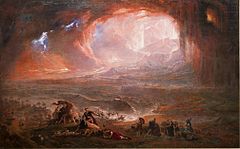| Eruption of Mount Vesuvius in 79 AD | |
|---|---|
 | |
| Volcano | Mount Vesuvius |
| Date | c. October 79 AD |
| Type | Plinian, Peléan |
| Location | Campania, Italy 40°49′17″N 14°26′34″E / 40.82139°N 14.44278°E |
| VEI | 5 |
| Impact | Buried the Roman settlements of Pompeii, Herculaneum, Oplontis, and Stabiae |
| Deaths | 1,500–3,500, possibly up to 16,000[1][note 1] |
Of the many eruptions of Mount Vesuvius, a major stratovolcano in Southern Italy, the best-known is its eruption in 79 AD,[2][3] which was one of the deadliest in history.[4]
Mount Vesuvius violently spewed forth a cloud of super-heated tephra and gases to a height of 33 km (21 mi), ejecting molten rock, pulverized pumice and hot ash at 1.5 million tons per second, ultimately releasing 100,000 times the thermal energy of the atomic bombings of Hiroshima and Nagasaki.[5][6] The event gives its name to the Vesuvian type of volcanic eruption, characterised by columns of hot gases and ash reaching the stratosphere, although the event also included pyroclastic flows associated with Pelean eruptions.
The event destroyed several Roman towns and settlements in the area. Pompeii and Herculaneum, obliterated and buried underneath massive pyroclastic surges and ashfall deposits, are the most famous examples.[4][5] Archaeological excavations have revealed much of the towns and the lives of the inhabitants leading to the area becoming the Vesuvius National Park and a UNESCO World Heritage Site.
The total population of both cities was over 20,000.[7][8] The remains of over 1,500 people have been found at Pompeii and Herculaneum. The total death toll from the eruption remains unknown.
- ^ "3 – Vesuvius in 79 AD Ranks Way Down the List of History's Deadliest Eruptions". History Collection. August 7, 2017. Archived from the original on December 18, 2022. Retrieved November 22, 2020.
- ^ Martin, Stephanie C. (May 1, 2020). "Past eruptions and future predictions: Analyzing ancient responses to Mount Vesuvius for use in modern risk management". Journal of Volcanology and Geothermal Research. 396: 106851. Bibcode:2020JVGR..39606851M. doi:10.1016/j.jvolgeores.2020.106851. ISSN 0377-0273. S2CID 216194471.
- ^ Vogel, Sebastian; Esposito, Domenico; Seiler, Florian; Märker, Michael (2012). Analysing the Rural Landscape around Pompeii before the Eruption of Somma-Vesuvius in AD 79 (PDF). Landscape Archaeology Conference (LAC 2012). ETopoi, Journal for Ancient Studies. Vol. Special Volume 3. pp. 377–382. Archived (PDF) from the original on June 14, 2022. Retrieved June 8, 2022.
- ^ a b Andrew Wallace-Hadrill (October 15, 2010). "Pompeii: Portents of Disaster". BBC History. Archived from the original on January 8, 2021. Retrieved February 4, 2011.
- ^ a b "Science: Man of Pompeii". Time. October 15, 1956. Archived from the original on December 14, 2008. Retrieved February 4, 2011.
- ^ Daley, Jason (October 10, 2018). "Mount Vesuvius Boiled Its Victims' Blood and Caused Their Skulls to Explode". Smithsonian Magazine. Archived from the original on October 10, 2018. Retrieved August 15, 2022.
- ^ Maiuri, Amedeo (April 1958). "Pompeii". Scientific American. 198 (4): 70. Bibcode:1958SciAm.198d..68M. doi:10.1038/scientificamerican0458-68. JSTOR 24940972.
- ^ Maiuri, Amedeo (1977). Herculaneum. Italy: Instituto Poligrafico Dello Stato, Libreria Dello Stato. p. 13.
Cite error: There are <ref group=note> tags on this page, but the references will not show without a {{reflist|group=note}} template (see the help page).